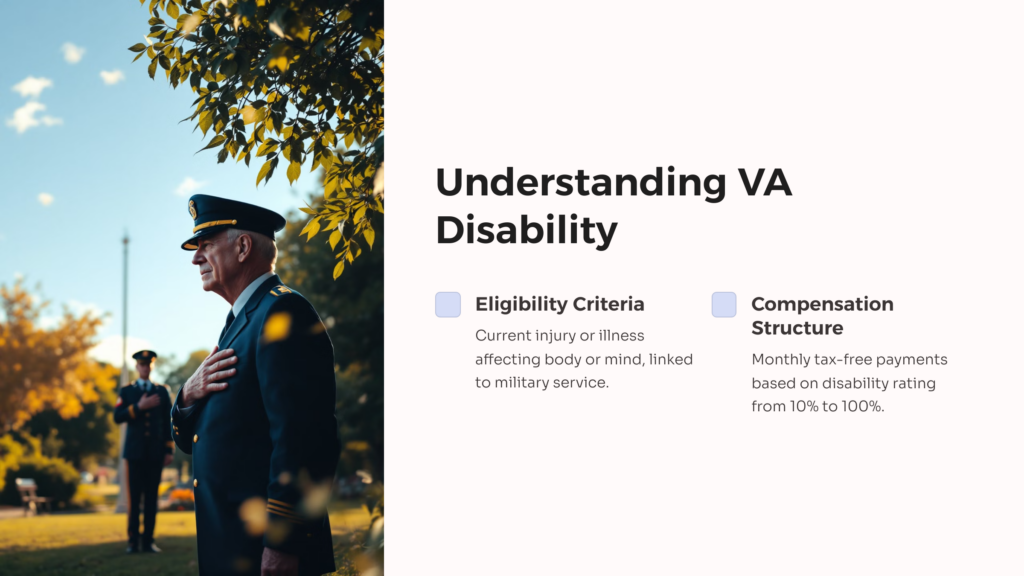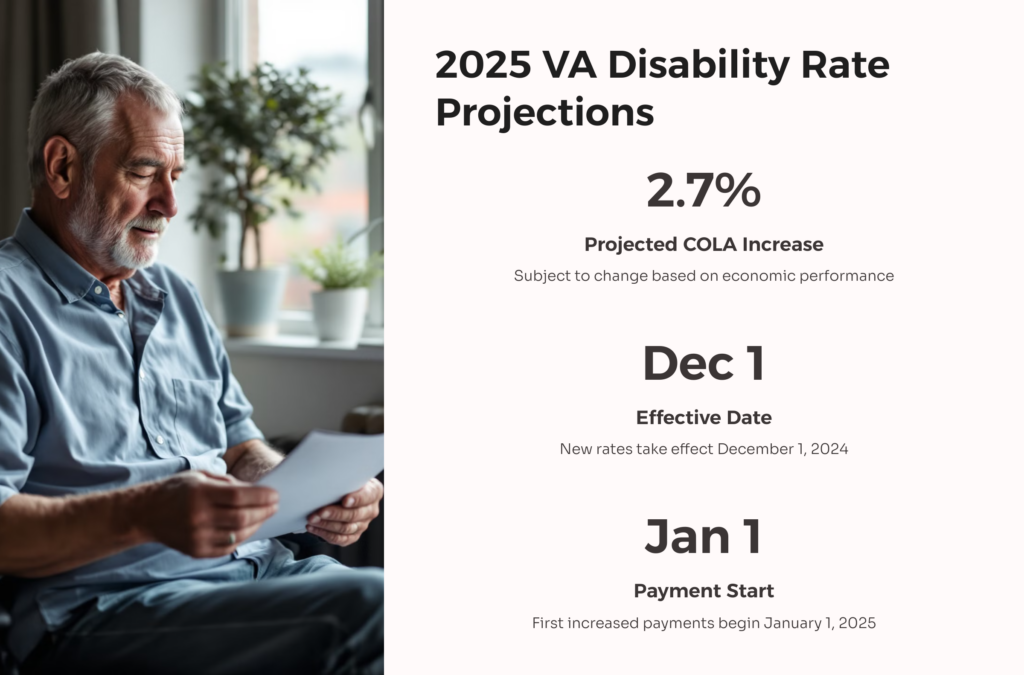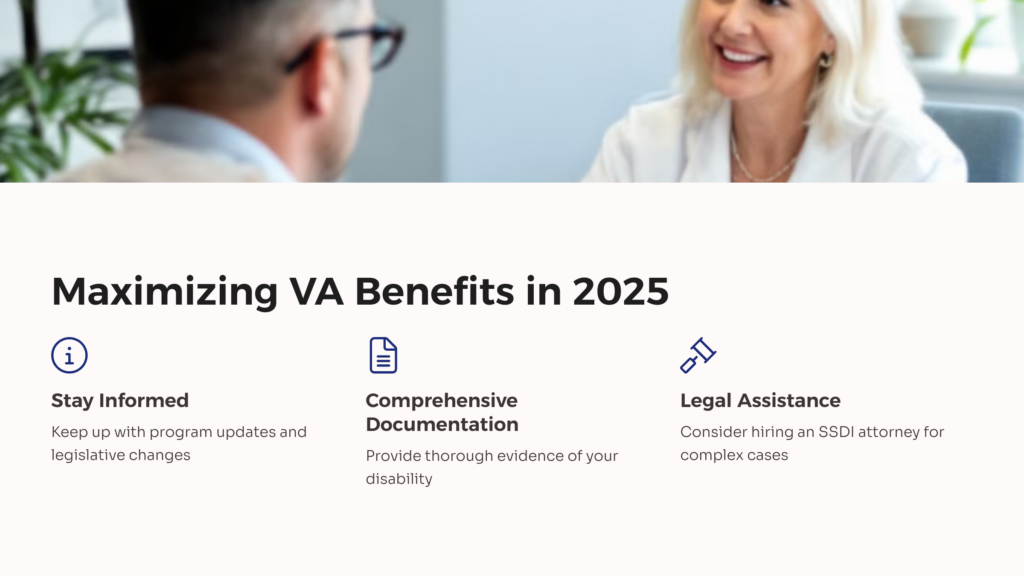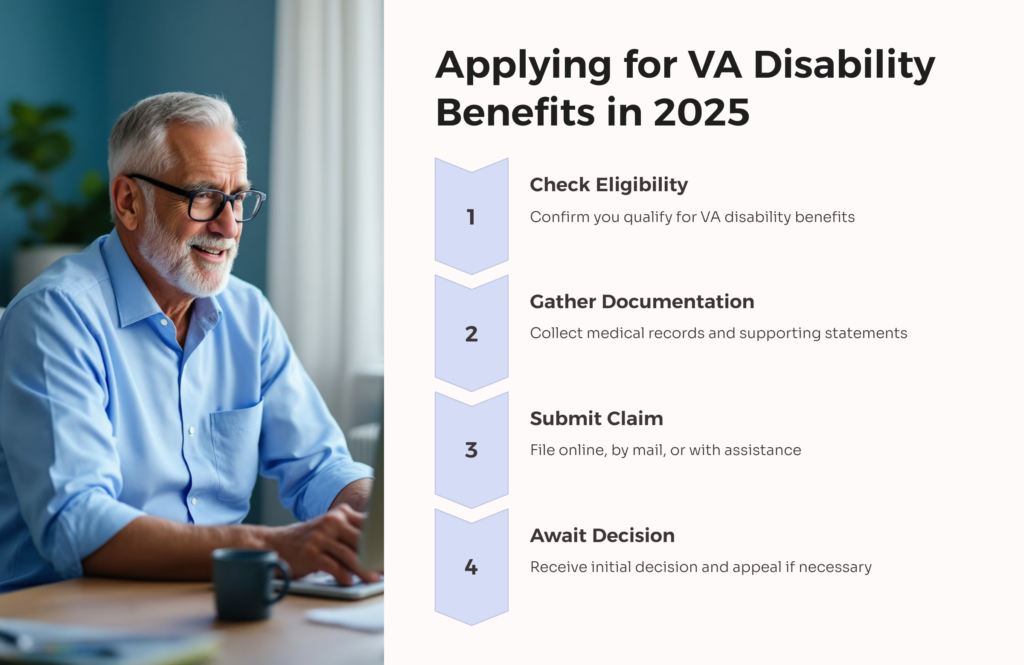Every year, the United States Department of Veterans Affairs (VA) examines the compensation rates for disability pay to determine whether disability benefits should be adjusted for inflation. Depending on economic performance, the VA determines whether to adjust the VA benefit rates to meet rising costs and inflation.
In 2025, VA disability rates are expected to increase by 2.7% to help military veterans and their families access necessities.
Due to high inflation rates caused by the pandemic, the COLA (cost of living adjustment) is expected to increase by 2.7% in 2025. The Social Security Administration determines COLA each year.
During the peak of the COVID-19 pandemic, the Federal Reserve’s support gave the United States a crucial influx of cash. This financial support will gradually decrease to stop the skyrocketing inflation rates and the slowdown in the economy. This article will discuss the changes to VA disability rates over the years, factors affecting VA disability payments, the 2025 VA disability rate projections, and the steps for applying for VA disability compensation in 2025.
Understanding VA Disability

The U.S. Department of Veterans Affairs (VA) pays tax-free monthly disability compensation to military veterans with a service-related disability. A service-related condition means an injury or illness caused by or aggravated by your active military service. The VA compensates veterans who got injured or became sick while serving in the military and veterans whose condition is further exacerbated because of their service in the military. You might qualify for VA disability compensation for mental conditions like post-traumatic stress disorder (PTSD) and physical conditions like injury or chronic illness that developed during, before, or after military service.
You might qualify for VA disability compensation if you meet these conditions:
- You have a current injury or illness that affects your body or mind, and
- You served on active duty for training, active duty, or inactive duty training.
Also, at least one of these conditions must be true:
- You got injured or became sick while serving in the military–and you can link that to your injury or illness; this is called an in-service disability claim or
- You have a disability connected to your active duty service that appeared after you ended your military service.
- You had an injury or illness before you served in the military–and serving in the military worsened it.
For some mental or physical conditions, the VA automatically assumes that your service caused the condition. That’s called presumptive conditions. If you’re suffering from a presumptive condition, you need not prove that your service caused the condition. You only need to meet service requirements for the presumption.
If you’re eligible for disability pay, the VA assigns a disability rating based on the seriousness of your condition. This disability rating determines how much compensation you receive each month. The VA graduates the compensation amount according to the degree of your disability on a scale from 10% to 100%–in increments of 10%.
The VA may also pay compensation for conditions related to or secondary to disabilities that occurred in service. Typically, the degrees of disability specified are also meant to compensate for the inability to work due to aggravations or illnesses.
Historical Overview of VA Disability Rates
The VA raises disability rates annually to accommodate the increase in the cost of living. An annual payment increment depends on the United States government’s increase in Social Security payments, known as COLA (Cost of Living Adjustment).
In 2024, VA disability rates saw a 3.2% increase over the previous year based on COLA calculations.
Because of 2023’s COLA, disability rates received an 8.7% cost-of-living increase, thus, for a 50% disabled military veteran with one child and a spouse receiving $1,118.44 monthly, that amounts to $97.38 more.
In 2022, VA disability rates received a 5.9% cost-of-living increment because of the COLA calculations. That means a 50% disabled veteran with one child and spouse who currently gets $1,056.04 monthly will receive $62.40 more.
The 2021 VA disability compensation rates increased by 1.3% because of the COLA calculations. Thus, for a 60% disabled military veteran with a spouse and one parent and without children who currently gets $1317.68, that amounts to $17.13 more a month.
2020 VA disability compensation rates increased by 1.6% because of 2020’s COLA calculations. Thus, for a 40% disabled military veteran with a spouse and no children who currently receive $685.73, that amounts to $10.97 more a month.
2019 VA disability rates increased by 2.80% because of COLA calculations. For a 30% disabled veteran with a spouse and no children who currently receive $466.15, that amounts to $13.05 more a month.
2018 VA disability rates saw a 2.00% increase due to COLA calculations.
The VA makes cost-of-living adjustments to disability rates annually to ensure inflation rates don’t erode VA compensation’s purchasing power. Per federal law, the cost-of-living adjustments to VA pension and disability rates are the same as those for Social Security benefits.
Factors Affecting VA Disability Rates
For many military veterans across the United States, the VA disability benefits are essential for financial security and healthcare access. As 2025 approaches, many veterans naturally worry about the outlook of these monetary programs. While some aspects will remain the same, others will likely change because of economic factors, legislative updates, and ongoing program assessments.
The VA routinely analyzes its current rate for disability compensation to ensure that benefit amounts effectively keep up with inflation and the rising cost of living. Any adjustment to the benefit amount based on this calculation is known as a Cost-of-Living Adjustment. According to federal law, any COLA adjustment to VA disability rates must equal the adjustment of Social Security benefits. This crucial policy prevents inflation from reducing the value of disability benefits.
Per law, the need for and value of COLA depends on the percentage increase in the CPI-W (Consumer Price Index for Urban Wage Earners and Clerical Workers) from the third quarter of the previous year. COLA is set in the third quarter of the current year.
COLA tends to be more when inflation rates are higher, as was the case in 2023, to help compensation keep up with rising costs. Conversely, COLA adjustments are minor or non-existent during economic downturns and low inflation periods.
2025 VA Disability Rate Projections

As of today, the projected COLA adjustment for 2025 VA disability rates is 2.7%. However, this projection could change depending on economic factors such as consumer spending, inflation, and overall economic performance. If inflation pressures slow down, it’s possible that 2025’s COLA could be less than 2.7%. However, we won’t know for sure until the SSA announces the official 2025 COLA increase in mid-October 2024. The disability rate will take effect on December 1, 2024, and disability payments will start on January 1, 2025.
How 2025 VA Disability Rates Affect Disability Compensation
The latest prediction for the 2025 COLA increase is 2.7%. This increase will be reflected in the VA disability rates starting from December 1, 2024, with disability payments beginning on January 1, 2025.
However, the 2025 COLA projection has been minimally depressed because of a lower-than-expected June 2024 CPI (Consumer Price Index) report. The report suggests a decline in inflationary pressures, which may ultimately affect the final COLA increase and even the VA disability rates for 2025. If inflation continues to decline, the actual COLA for 2025 and even the disability compensation rates might be lower than the current prediction. These adjustments ensure that the purchasing power of disability compensation keeps up with inflation.
For example 2025, the projected disability pay rate is 2.7%. That increase means that disability pay will rise incrementally across rating percentages. For instance, veterans with a 30% disability rating will see their benefits increase to $538.10 per month, up from $524.31 in 2024. Also, a military veteran with an 80% disability rating with a spouse and two parents and without children will see their disability pay increase to $2,490.84 per month from $2,427.01 in 2024.
Tips on Maximizing Benefits from VA Benefits in 2025

Military veterans can maximize their VA disability payments in 2025 by staying informed about program updates, legislative changes, and the available resources. They should also contact advocacy organizations and the VA to stay informed and engaged.
Here are some ways you can maximize your VA benefits in 2025:
- Stay informed: In 2025, expect wider access to disability benefits because of expanded eligibility criteria. That means more military veterans will have access to the compensation they deserve. Thus, you must watch out for updated legislation and programs designed to serve military veterans better to qualify for more benefits.
- Provide comprehensive documentation of your disability: Ask for help from your doctors in describing your diagnosis. Be thorough about how your disability hampers you from doing things. The more you can explain how your condition is disabling, the better the odds of getting the benefits you deserve. Even if you’re eligible for disability benefits, the VA may deny your claim because of a lack of information.
- Consider other types of compensation: You may qualify for additional benefits besides disability benefits every month. Thus, you must watch for other governmental assistance for which you may be eligible. You should also consider local assistance programs or social services in your area.
- Hire an SSDI attorney: The VA doesn’t make it easy for anyone to receive disability pay, let alone maximize the amount they give to each person. Despite the complexities surrounding applying for and maximizing VA benefits, you aren’t alone in this legal journey. An experienced attorney can help you:
- Review all aspects of your claim and disability case
- Help you throughout the application process or appeal process to make sure things go smoothly
- Handle your communications with the VA and other parties involved
- Represent your best interest always
Remember, VA benefits aren’t a handout or charity. You earned this compensation by serving this country. So, don’t feel guilty about seeking the maximum benefits you deserve.
- Update the VA about any changes as soon as possible: If there’s any change in your life, let the VA know immediately. If you’re eligible for higher benefits, you want to start receiving them right away. Further, if you need to retire early due to your disability, consider applying for disability benefits first. By doing so, you’ll avoid receiving low retirement benefits. Then, you can start getting Social Security benefits as soon as you reach retirement age.
Steps to Apply for VA Disability Benefits in 2025

To apply for VA disability benefits in 2025:
- Find out if you qualify for VA disability benefits. You’re eligible for VA disability payments if you have a service-related condition.
- Fill out your disability claim completely.
- Gather all supporting documents you’ll submit when you file your disability claim. It’s crucial to send in all your supporting documentation along with your VA disability claim. This helps the VA process your disability claim quickly. You can support your disability claim by providing this documentation:
- Private medical records and hospital reports
- Hospital records and VA medical records
- Supporting statements from family members, friends, law enforcement personnel, clergy members, or those you served with. These statements will tell the VA more about your claimed disability and how and when it occurred or how it worsened.
- Find out if you must submit additional forms with your disability claim. Learn more about additional forms you might have to file.
- Submit your claim. You can submit your disability claim online, by mail using VA Form 21-526EZ, in person by taking your application to a VA regional office near you, by fax, or you can also work with an accredited claims agent, attorney, or Veterans Service Organization to help you file your claim.
- Await the initial decision. The VA will evaluate your claim and might schedule a medical examination if necessary.
- Receive final decision. You’ll receive a decision letter outlining approved disability benefits. However, if the VA denies your claim, you can appeal that decision within one year.
- File an appeal if necessary. If you disagree with the VA’s decision, you can hire a disability attorney to help you file an appeal. Be sure to submit additional evidence to support your claim.
Other Considerations for 2025 VA Disability Rates
Here are other considerations for 2025 VA disability benefits:
- Tax implications: VA disability benefits aren’t taxable. So, you don’t have to include them as part of your income on your tax returns. Tax-free disability payments include:
- Grants for homes designed for wheelchair living
- Disability payments and pension benefits paid to disabled veterans or their families
- Grants for motor vehicles for military veterans who lost the use of their limbs or their sight
- Disability pay under dependent-care assistance programs
If the VA increases your disability rating, you might qualify to claim a federal tax refund in the year when the VA does that. Further, if you’re a combat-disabled military veteran receiving Combat-Related Special Compensation (CRSC) following an award for Concurrent Retirement and Disability, you might qualify for a tax refund the year the VA grants you the CRSC.
- Special Monthly Compensation. This is a supplementary tax-free disability benefit the VA pays to military veterans, surviving spouses, their spouses, and parents. For military veterans, this is a higher rate of disability payments paid because of special circumstances like the need for assistance and attendance from other people or by special disability, like the loss of one leg or hand. This compensation is often known as aid and attendance for spouses and surviving spouses of veterans. It is paid depending on the need for assistance and attendance from another person.
- Dependency and Indemnity Compensation. The VA pays this tax-free disability compensation to a surviving parent, child, or spouse of servicemembers who passed away while on active duty, inactive duty training, or active duty for training or to survivors of military veterans who passed away due to service-related disabilities.
- Combined disability ratings. The VA calculates a combined disability rating for military veterans with multiple disabling conditions using a combined rating table and rounds the final number to the nearest 10%.
Conclusion: 2025 VA Disability Rates
The 2025 VA compensation rates are expected to increase by 2.7% starting December 1, 2024. This prediction follows the SSA’s recent announcement concerning the COLA adjustment.
Even though the precise increment will be confirmed on October 12, 2024, the official rates reflecting this increase will start in December. Thus, veterans and their families must stay updated with the latest announcements from the VA to ensure they get maximum financial support to cover their needs. To learn more about 2025 VA disability rates, visit our website.
 AllVeteran.com Advisors
AllVeteran.com Advisors
With expertise spanning local, state, and federal benefit programs, our team is dedicated to guiding individuals towards the perfect program tailored to their unique circumstances.











